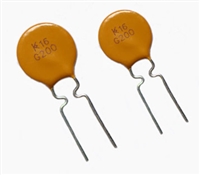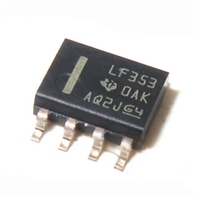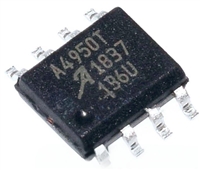The trip point ideally occurs at the
centerline of the internal probe or external
electrode; this can be trimmed with a
In the case of coaxial probes, the ground
connection is inherent in the outer cylinder
and no further ground connection is
required.
potentiometer
if
necessary
(see
Section 3.2). Making the electrode narrow
and long (horizontally) will help keep the
trip point localized within a narrow band.
3 PROCESSING AND
CIRCUITRY
2.4 DUAL LEVEL SENSING
When two trip levels are desired, for
example for high-low limit sensing, the
electrode or probe set should have two
3.1 SLOSH FILTER
It is desirable to suppress rapid, multiple
detections of fluid level generated by the
surface movement of the fluid, for example
in a moving vehicle. To accomplish this,
distinct tiers.
A typical twin external
electrode is shown in Figure 2-3 (they are
connected together to the sense line);
typical internal twin electrodes are shown
in Figures 2-6, 2-7, 2-9, and 2-11. The
response of a properly constructed 2-tier
probe is shown in Figure 2-3.
the QT114 incorporates
a
detection
integration counter that increments with
each detection until a limit is reached, after
which point one of the OUT lines is
activated. If during a detection ‘event’ the
fluid level falls below the electrode level
(signal rises above a 'T' point in signal
counts), the counter decrements back
towards zero. Over a long interval the up
and down counts will tend towards either
zero or the limit, with the result being a
statistical function of the number of
detections vs. nondetections. If on average
there are more detections than nondetections, the counter
will eventually make its way to the limit value and an OUT line
will activate.
Dual level electrodes should have an
approximately 3:1 surface area ratio or
more from T2 to T1; that is, the surface
area at T2 should be at least 3x the
surface area of the electrode at T1. There
is no penalty for making T2 excessively
large. The high ratio is required to
Figure 2-12 A two-tier spiral wire
probe with ground rod
overcome the QT114's decreasing gain with increasing Cx
load (Figures 4-1, 4-2).
With internal dual-level probes where T1 and T2 are
substantially separated, the intervening connection between
the two levels should be more thickly insulated, for example
with a thick plastic spacer, and any remaining internal gap
inside the spacer should be filled with silicone sealant or
epoxy. This will help to prevent the signal from rising much
between the two levels, thus preserving a crisp bi-level
response like that shown in Figure 2-3.
Once a detection has been established, the counter must find
its way back to zero before the affected OUT line goes
inactive, via the same process. Although the counter has a
nominal reaction time of 15 seconds, in some cases it may
take several minutes before the outcome is resolved
depending on the violence of the fluid surface. If the fluid
surface is stable however, it will only require 15 seconds to
change the state of an OUT line.
2.5 GROUNDING CONSIDERATIONS
In all cases ground reference coupling to the fluid must be
made. In aqueous fluids, this can simply mean connecting
the metal vessel to circuit ground, or inserting a bare metal
element into the bottom of a plastic or glass vessel. The
degree of galvanic contact is not critical, so scale and
corrosion on the ground electrode are not of great concern
especially if the 'connection' to the fluid is substantial enough .
Both OUT1 and OUT2 have their own independent slosh
filters. Both are enabled or disabled in unison by strap option,
pin 4, 'FILT' as follows:
FILT = Gnd
FILT = Vcc
Slosh filter off
Slosh filter on
FILT strapping can be changed 'on the fly'.
If direct electrical contact to the fluid is not possible, a large
piece of external metal can be bonded to the outside of the
vessel and grounded. Once this is done, the signal should be
monitored while the vessel is touched by hand; if the
grounding is sufficient, the signal will not move or will move
only slightly.
3.2 CALIBRATION
Both the T1 and T2 trip point values are hardwired internally
as functions of counts of burst length. Sensitivity can be
altered relative to these trip points by altering electrode size,
geometry, degree of coupling to the fluid, and the value of
Cs. Selecting an appropriate value of Cs for a given electrode
geometry is essential for solid detection stability.
Very large vessels, even if not grounded, often do not require
additional provision for grounding since the bottom surface
area and free-space capacitance of the tank may be
sufficient for ground return coupling.
The QT114 employs dual threshold points set at 250 and 150
counts of acquisition signal. The signal travels in a reverse
direction: increasing Cx reduces the signal counts; as a
result, 250 counts of signal corresponds to the most sensitive
or ‘lower’ setting (T1), and 150 the least sensitive 'upper'
setting (T2).
In some cases (windshield washer tanks on cars for
example) there will exist a water path to a chassis-grounded
fitting somewhere downstream of the tank, or the water path
may be labyrinthine enough to provide enough capacitive
coupling to the grounded chassis even if it does not make
galvanic contact. In these cases no further provision for fluid
grounding is required. Simple experimentation will easily
determine whether the existing amount of parasitic coupling
to ground is enough to do the job.
LQ
6
QT114 R1.04/1106






 NTC热敏电阻与PTC热敏电阻的应用原理及应用范围
NTC热敏电阻与PTC热敏电阻的应用原理及应用范围

 GTO与普通晶闸管相比为什么可以自关断?为什么普通晶闸管不能呢?从GTO原理、应用范围带你了解原因及推荐型号
GTO与普通晶闸管相比为什么可以自关断?为什么普通晶闸管不能呢?从GTO原理、应用范围带你了解原因及推荐型号

 LF353数据手册解读:特性、应用、封装、引脚说明、电气参数及替换型号推荐
LF353数据手册解读:特性、应用、封装、引脚说明、电气参数及替换型号推荐

 A4950资料手册解读:特性、应用、封装、引脚功能、电气参数及代换型号
A4950资料手册解读:特性、应用、封装、引脚功能、电气参数及代换型号
